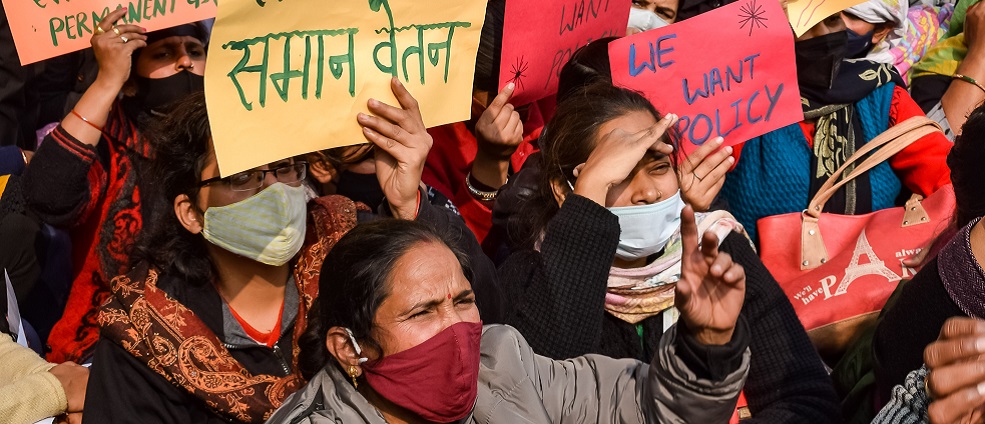Mae'r cynnwys hwn ar gael yn Saesneg yn unig.
New research by WISERD co-director, Professor Paul Chaney examines state and civil society organisation (CSO) perspectives on the contemporary situation of human rights defenders (HRDs) in South Asia using data submissions to the Universal Periodic Review (UPR), the United Nations five-yearly monitoring process.
“Human rights defender” refers to anyone acting to: address any human right on behalf of individuals or groups; the promotion, protection and realisation of economic, social and cultural rights; collecting and disseminating information on violations. Protections for HRDs are set out in the United Nations Declaration on Human Rights Defenders.
Civil society is the civic space wherein HRDs mobilise and advocate to uphold human rights and democracy. Yet the past decade has seen increasing government repression leading the UN to refer to the “wider situation of shrinking civic space around the world” and a “crack-down on human rights defenders”. This study addresses a knowledge-gap as hitherto there has not been a study of human rights defenders and the applicability of a shrinking civic space to South Asia.
Key findings
This study’s analysis of South Asian governments’ UPR reports shows how their engagement with the monitoring of their UN human rights treaty obligations is characterised by performativity and legitimation. In other words, they appear to embrace the promotion of HRDs’ rights in a way that advances governments’ political legitimacy on the international stage. However, drawing on CSOs’ UPR discourse, this study reveals that HRDs face a raft of rights violations, including threats, violence and murder. Their work is being curtailed by increasing state restrictions on freedom of association and expression. The malaise is compounded by impunity for offenders, corrupt practices and governments’ failure to respond to earlier UPR recommendations.
The analysis shows a strong gendered dimension to HRD oppression with clear evidence of how, across the region, women human rights defenders (WHRDs) are more vulnerable than their male counterparts to threats and violence. As this CSO noted, we are ‘alarmed by the continuing levels of violence against women and the desperate situation faced by women HRDs in Afghanistan, who face a heightened level of persecution because of their gender and their human rights activism’.
The study shows how states employ diverse means to terrorise WHRDs. As this CSO explained, in Sri Lanka there are extensive ‘threats and intimidation to human rights defenders. The military and State intelligence officers continue to monitor and carry out inquiries of human rights activists…They have also formed informants amongst the public in order to obtain information on activities carried out by civil society activists. WHRDs who are working at civil society organizations are visited by the intelligence [service] and inquiries are taking place regarding their work’.
The threats and gender-based violence are compounded by religious extremism and, in particular, conservative, faith-based attitudes on the ‘appropriate’ role of women in society. For example, in Pakistan this CSO referred to how ‘security agencies, religious groups, militants, and armed gangs all target HRDs … [there is] Brutal sectarian violence. HRDs working to defend the rights of women in the tribal areas where extremist groups operate face the highest risks’. Moreover, as this CSO explained: ‘The pervasive nature of threats against WHRDs is largely due to the hostile atmosphere towards women in many parts of Afghanistan, most visibly demonstrated by attacks perpetrated by the Taliban and other armed groups against women who do not adhere to a strict religious code’.
The analysis of CSOs’ UPR submissions includes graphic accounts of the murder of WHRDs. For example, this CSO recounted how: ‘On 25 April 2015, unidentified gunmen shot and killed a woman human rights defender (WHRD) [name…] outside the arts venue she founded in Karachi. She was a prominent HRD in Pakistan. In 2007, she set up “The Second Floor” as a forum to host public discussion around human rights, blasphemy, cultural diversity, extremism, and peacebuilding’.
Significance?
These findings underline the extension to South Asia of what has been dubbed ‘a shrinking civic space’ and ‘counter-associational revolution’, or the rise, spread, and contagion of restrictive legislation. This study provides new evidence of the scale and seriousness of the threat to democracy and the freedom and safety of HRDs working to uphold human rights in the region. It underlines that key reforms are urgently required, including measures to ensure the legal enforcement of the UN Declaration on Human Rights Defenders.
You can read the full research findings in the forthcoming international journal article:
Chaney, P. (2022 forthcoming) Shrinking Civil Space? Exploring State and Civil Society Perspectives on the Contemporary Situation of Human Rights Defenders in South Asia, Journal of South Asian Development, SAGE https://journals.sagepub.com/home/sad

